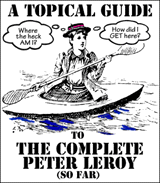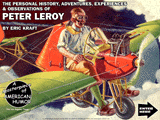
by Mark Dorset
Dostoevsky’s Unnamed Anti-Hero on Life versus an Imitation of Life, or Reality versus Reality TV:
![]() o
tell a long story about how I missed life through decaying morally in a
corner, not having sufficient means, losing the habit of living, and carefully
cultivating my anger underground—really is not interesting; a novel needs
a hero, but here all the features of an anti-hero have purposely been collected,
and most of all, the whole thing produces a bad impression, because we
have all got out of the habit of living, we are all in a greater or less
degree crippled. We are so unused to living that we often feel something
like loathing for “real life” and so cannot bear to be reminded of it.
We have really gone so far as to think of “real life” as toil, almost as
servitude, and we are all agreed, for our part, that it is better in books
[on TV]. And what is it we sometimes scratch about for, what do we cry
for, what do we beg for? We don’t know ourselves. . . . Look harder! After
all, we don’t even know where “real life” is lived nowadays, or what it
is, what name it goes by. Leave us to ourselves, without our books [TV
sets], and at once we get into a muddle and lose our way—we don’t know
whose side to be on or where to give our allegiance, what to love and what
to hate, what to respect and what to despise. We even find it difficult
to be human beings, men with real flesh and blood of our own; we are ashamed
of it, we think it a disgrace, and are always striving to be some unprecedented
kind of generalized human being. We are born dead, and moreover we have
long ceased to be the sons of living fathers; and we become more and more
contented with our condition. We are acquiring the taste for it. Soon we
shall invent a method of being born from an idea. But that’s enough; I
shall write no more from the underground.
o
tell a long story about how I missed life through decaying morally in a
corner, not having sufficient means, losing the habit of living, and carefully
cultivating my anger underground—really is not interesting; a novel needs
a hero, but here all the features of an anti-hero have purposely been collected,
and most of all, the whole thing produces a bad impression, because we
have all got out of the habit of living, we are all in a greater or less
degree crippled. We are so unused to living that we often feel something
like loathing for “real life” and so cannot bear to be reminded of it.
We have really gone so far as to think of “real life” as toil, almost as
servitude, and we are all agreed, for our part, that it is better in books
[on TV]. And what is it we sometimes scratch about for, what do we cry
for, what do we beg for? We don’t know ourselves. . . . Look harder! After
all, we don’t even know where “real life” is lived nowadays, or what it
is, what name it goes by. Leave us to ourselves, without our books [TV
sets], and at once we get into a muddle and lose our way—we don’t know
whose side to be on or where to give our allegiance, what to love and what
to hate, what to respect and what to despise. We even find it difficult
to be human beings, men with real flesh and blood of our own; we are ashamed
of it, we think it a disgrace, and are always striving to be some unprecedented
kind of generalized human being. We are born dead, and moreover we have
long ceased to be the sons of living fathers; and we become more and more
contented with our condition. We are acquiring the taste for it. Soon we
shall invent a method of being born from an idea. But that’s enough; I
shall write no more from the underground.
Notes from Underground
Wallace Stevens on the Role of Reality in Art:
![]() eality
is the beginning not the end.
eality
is the beginning not the end.
“An Ordinary Evening in New Haven”
E-mail it to me, Mark Dorset.

 Here
are a couple of swell ideas from Eric Kraft's vivacious publicist, Candi
Lee Manning:
Here
are a couple of swell ideas from Eric Kraft's vivacious publicist, Candi
Lee Manning:
